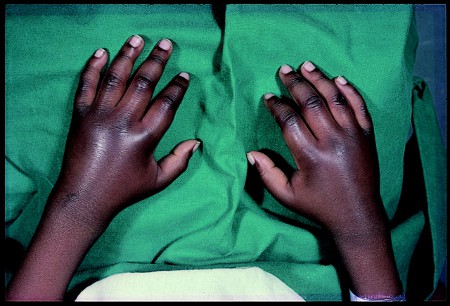History and exam
Key diagnostic factors
common
parent(s) diagnosed with sickle cell anemia, other sickle cell disease, or sickle cell trait
Autosomal recessive trait. Individuals heterozygous for an abnormal hemoglobin gene are asymptomatic and therefore act as carriers for the condition.
persistent pain in skeleton, chest, and/or abdomen
Acute symptom of vaso-occlusive/painful crises.
dactylitis
Swollen dorsa of hands and feet consistent with hand-foot syndrome, which can be presenting symptoms in young infants and children. By 2 years of age, 25% of American and 50% of Jamaican children with sickle cell anemia have experienced at least one episode of dactylitis.[21][Figure caption and citation for the preceding image starts]: Hand-foot syndrome in patient age 14 months with homozygous sickle cell diseaseFrom: Davies SC, Oni L. BMJ. 1997 Sep 13;315(7109):656-60 [Citation ends].
Often a child's first presentation of disease. Earlier onset associated with worse prognosis.[22]
Other diagnostic factors
common
high temperature
Oral temperature over 101.3°F (38.5°C), cough, watery stools, tender abdomen, malaise, chest pain, diarrhea, and/or vomiting are suggestive of infection. In children with fever, careful investigation for source and close observation are required to rule out life-threatening infections.
pneumonia-like syndrome
Sickling of red blood cells within the pulmonary vasculature results in acute chest syndrome. This can be clinically indistinguishable from pneumonia and can cause chest pain, fever, dyspnea, tachypnea, and hypoxemia. Diagnosed when the patient has fever, chest pain, and infiltrate on chest x-ray.
Can be brought on by anything that causes hypoxia, including macro/microvascular thrombosis, atelectasis, and infection.
bone pain
visual floaters
Sickling and occlusion of small retinal arterioles can lead to neovascularization and, if untreated, to hemorrhage, retinal detachment, and visual loss.
tachypnea
Indication of acute chest syndrome.
failure to thrive
Presenting sign in infants and may occur due to anemia and a hypermetabolic state.
pallor
Indication of splenic sequestration or hemolysis.
jaundice
Indication of hemolysis.
tachycardia
Indication of splenic sequestration or hemolysis.
lethargy
Indication of splenic sequestration or hemolysis.
uncommon
protuberant abdomen, often with umbilical hernia
Presenting sign in infants due to an enlarged spleen.
cardiac systolic flow murmur
Presenting sign in infants secondary to anemia.
maxillary hypertrophy with overbite
Presenting sign in infants due to extramedullary hematopoiesis, which occurs in some forms of the disease.
shock
Indication of splenic sequestration.
Risk factors
strong
genetic
Sickle cell anemia is inherited in an autosomal recessive pattern.
When both parents carry the recessive sickle cell gene, there is a 1 in 4 chance that their offspring will inherit two recessive alleles, causing sickle cell anemia.
Use of this content is subject to our disclaimer